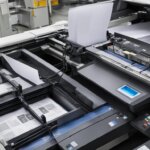Table of Contents
Printing has come a long way, from the traditional printing methods to the modern ones. Inkjet technology is one of the most widely used printing technologies today. But what is inkjet? Inkjet technology involves the propelling of tiny droplets of ink onto a surface to create text or images.
Inkjet printers are popular for both personal and professional use due to their ability to produce high-quality prints. From printing images, documents to even creating textiles, inkjet technology has diverse applications that transform various industries.
Key Takeaways:
- Inkjet technology involves the propelling of tiny droplets of ink onto a surface to create text or images.
- Inkjet printers are popular for both personal and professional use.
- Inkjet technology has diverse applications that transform various industries.
- Inkjet printing is known for producing high-quality prints.
How Does Inkjet Technology Work?
Inkjet technology is a printing process that uses small droplets of ink to create high-quality prints. The mechanism of inkjet printers involves the use of microscopic nozzles that spray ink onto a surface, such as paper or textiles.
The ink is stored in cartridges, which are housed in the printer. When a document or image is sent to the printer, a mechanism moves the print head across the page, selectively firing droplets of ink from the nozzles to create the desired image or text.
The high precision of inkjet technology allows for sharp and detailed images to be printed, as well as the use of a wide range of colors. There are several different types of inkjet technology available, including thermal, piezoelectric, continuous, and drop-on-demand.
Thermal inkjet technology uses heat to create a bubble in the ink cartridge, which ejects ink droplets onto the paper. Piezoelectric inkjet technology uses electrical charges to push ink through the nozzle. Continuous inkjet technology uses a constant flow of ink, which can be selectively charged to create an image. Drop-on-demand inkjet technology only ejects ink droplets when necessary, making it more efficient than other types of inkjet technology.
The advantages of inkjet printing include its versatility, cost-effectiveness, and ability to create high-quality, full-color prints. Additionally, inkjet technology requires less energy than other printing methods, making it more environmentally friendly.
“Inkjet technology has revolutionized the printing industry by offering high-quality, cost-effective printing solutions for both personal and professional use.”
Key Applications of Inkjet Technology
Inkjet technology has a wide range of applications in various industries. The uses of inkjet printing continue to expand as new advances are made in the field. Some of its key applications include:
| Application | Description |
|---|---|
| Printing high-resolution photographs | Inkjet printers can produce high-quality prints with vibrant colors and sharp details, making them ideal for printing photographs. |
| Creating vibrant marketing materials | Inkjet technology allows for the creation of eye-catching marketing materials such as brochures, flyers, and banners. Its ability to print on a variety of media types enables businesses to create custom marketing materials that stand out. |
| Producing textiles | Inkjet technology allows businesses to print customized designs on textiles, including clothing, upholstery, and wallpaper. This method of printing is highly precise and can produce elaborate designs with vibrant colors. |
| Manufacturing electronic components | Inkjet technology can be used to print electronic components such as circuits and displays. This method of manufacturing is cost-effective and can produce intricate designs with high precision. |
These are just a few examples of the many uses of inkjet printing. As technology continues to evolve and new applications are discovered, we can expect the list of inkjet technology applications to continue growing.
Conclusion
Inkjet technology has transformed the printing industry, providing affordable and high-quality printing solutions for personal and professional use. Its ability to produce intricate designs, vibrant colours, and precise details has made it a valuable asset in the digital era. From printing documents at home to creating large-scale advertising materials, inkjet technology has revolutionised the way we print and communicate. It offers a variety of applications, including printing high-resolution photographs, creating eye-catching marketing materials, producing textiles, and even manufacturing electronic components.
With its versatility and cost-effectiveness, inkjet technology will continue to shape the future of printing. It has come a long way since its inception and is continuously evolving to meet the growing demands of printing technology. Whether it’s for personal or commercial use, inkjet technology has undoubtedly made printing more accessible, efficient, and environmentally friendly.
FAQ
What is inkjet technology?
Inkjet technology refers to the method of printing by propelling tiny droplets of ink onto a surface. It is a widely used printing technology that offers high-quality prints with vibrant colors and sharp details.
How does inkjet technology work?
Inkjet technology works by using a print head that contains tiny nozzles. These nozzles spray ink droplets onto the paper or other media to create an image or text. The ink droplets are controlled by precise electrical signals, ensuring accuracy in printing.
What are the advantages of inkjet technology?
Inkjet technology offers several advantages. Firstly, it can produce high-resolution prints with rich color reproduction. Additionally, it is a versatile printing method that can handle various media types, including paper, fabric, and even ceramics. Inkjet technology is also cost-effective as it eliminates the need for printing plates or screens.
What are the key applications of inkjet technology?
Inkjet technology finds applications in various industries. It is commonly used for printing photographs, creating promotional materials such as brochures and banners, producing textiles with custom designs, and even manufacturing electronic components. Its versatility makes it an essential tool in today’s digital world.
Can inkjet technology be used for commercial purposes?
Yes, inkjet technology is widely used in commercial settings. It is employed in large-scale printing for advertising purposes, producing packaging materials, and creating high-quality prints for art galleries and museums. Its ability to handle large volumes of printing makes it suitable for commercial use.
Is inkjet technology suitable for home use?
Inkjet technology is ideal for home use. It allows for convenient and high-quality printing of documents, school projects, and personal photographs. Inkjet printers are compact and affordable, making them accessible to individuals for personal printing needs.
What types of inkjet technologies are available?
There are different types of inkjet technologies available, including thermal inkjet and piezoelectric inkjet. Thermal inkjet technology uses heat to create small bubbles that propel the ink onto the printing surface, while piezoelectric inkjet technology uses electrical signals to control the movement of the ink droplets.













